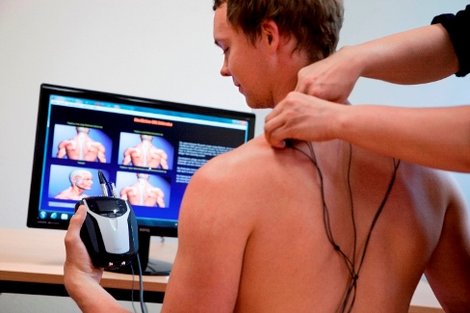When computer scientists step in and help doctors

The best medicine is the doctor – so say both studies and life experience. But what if there is no doctor – because no successor was found for the family practice in a sparsely populated region, or because an aging population needs more medical care than the current capacity is able to provide? This is where telemedicine – an example of E-health – can step in. Computer scientists in Saxony-Anhalt are collaborating closely with doctors, transforming measured data into images, helping to transfer data, and therefore improving medical care.
An example from the city of Halle an der Saale. Here, the public housing association Hallesche Wohnungsgenossenschaft FREIHEIT eG is examining the practicability of telemedicine in a pilot project with several partners. With the possibilities offered by telemedicine, medical treatment services in the home or in critical areas of care can be assured by providing support to medical doctors, for example. Furthermore, the self-sufficiency and quality of life of the affected patients can be significantly improved.
Great value basic research
While telemedicine is easing the burden during daily life and reducing the time needed to travel to the doctor and for waiting, Saxony-Anhalt researchers are also addressing fundamental questions in the field of medicine, in which data processing plays a key role. In this context, Prof. Dr. eng. Bernhard Preim and Dr. eng. Benjamin Köhler, a computer visualist at the Institute for Simulation and Graphics in the Faculty of Computer Science at Otto-von-Guericke University, Magdeburg, have developed a software package known as "Bloodline", which analyses the blood turbulence on the walls of the coronary arteries. Both are computer scientists. Bernhard Preim admits to being personally "infected" with the subject of medicine: he is married to Dr. Uta Preim, who is a radiologist. "The project was initiated by my wife, who worked as a radiologist for a year at the Cardiology Centre in Leipzig and naturally knew that we, as computer scientists, could contribute to the evaluation of blood flow data." The development of the algorithms and software has been managed almost entirely by Benjamin Köhler." Professor Preim is proud of his “extremely proficient doctoral student". The topic as a whole is as relevant in the world of medical research as it is in computer science research. Taking third place in the area of basic research as part of the Hugo Junkers Prize 2016 was an additional reward for their work – in addition to the recognition that they have gained at the professional level.
What will become of Bloodline? "The software is a prototype for research purposes only. The 4D PC-MRI measurement technology, which is the official name of Bloodline, is still a long way from being suitable for use in everyday clinical practice,” explains Benjamin Köhler. The software is, however, currently being used for studies and further research at the University Hospital in Magdeburg and in the Cardiology Centre in Leipzig. Both Uta Preim and PhD students work with the software, and regularly give their feedback to Benjamin Köhler. The ultimate purpose of the software is to provide predictive – and therefore better – treatment options for diseases of the coronary arteries.
Time is health
Otto-von-Guericke-University is also committed to the practice of telemedical research, however, so as to enable stroke patients to receive the rapid help that they require when no specialist hospital care is available in their immediate vicinity. "With our Telemedical Acute Stroke Care, or TASC, we have been able to ensure that patients who suffer a stroke receive the medicine they need as quickly as possible in the immediate aftermath – so that they benefit from significantly improved chances of recovery," highlights Peter Knüppel. The University has founded a network in which several clinics in the northern part of Saxony-Anhalt have participated. The patient data has been evaluated at Magdeburg University Hospital and the treatment has been provided on-site. Short decision-making paths, rapid help, better recovery. "We have now reached a point at which the research potential has been exhausted, so we have stepped down from our role of medical technicians. The TASC is still going strong, however." Computer scientist Knüppel is happy with the project’s sustainability. The ASTER project has emerged as something of a follow-up development. In this project, businesses and the university have joined forces to optimise the equipment available in ambulances for the optimal care of stroke patients.
The proximity between the physicians, computer scientists, computer visualists and other specialists in Saxony-Anhalt helps experts to apply their knowledge in networks on a focused basis. It is on this basis that they have succeeded in developing Bloodline and TASC, and are inviting participants to join the "Living 4.0" project. Saxony-Anhalt can be seen to punch above its weight – thanks to its well-educated and ambitious young researchers who want to invent "something which is useful".
Author: Renate Wähnelt
Photo: Hasomed GmbH
